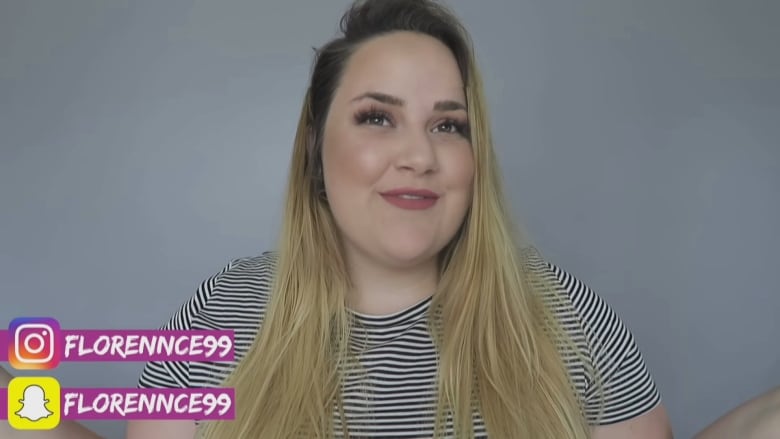
Florence Lavoie is 22 years old, works at home producing and distributing French language videos on YouTube. It’s lightweight, slice-of-life stuff, mostly: tips on makeup, dating, shopping and diet (one September post ranking lip balm flavours picked up 34,000 views).
She’s been posting videos online since age 10. Her bubbly, upbeat on-camera persona has earned her north of 85,000 subscribers — enough to make YouTube her full-time job, enough to bring her to the attention of the Government of Canada, which hired her in March to produce and distribute a short online video warning young people about the dangers of opioid abuse.
“There is an agency from Montreal that contacted me and talked to me about the project,” Lavoie said. “So already I was interested in sending a nice message to the young people that follow me, because there’s a crisis and people can get involved and touched by that.”
A ‘new era of celebrities’
The Public Health Agency of Canada paid Lavoie and four other social media influencers $17,700 in total to raise awareness about the dangers of opioid misuse. Lavoie’s video earned her $6,600.
“It’s like the new era of celebrities, if I can say (that). People look up to us and they’ll take our advice,” she said.
Nice work if you can get it — and you can get it if you try. The Trudeau government has been actively courting people with significant online audiences to help it communicate its messages to the Canadians who tend to tune out traditional government communications strategies.

Florence Lavoie holds forth on her YouTube channel. “Younger people don’t really watch television anymore,” she says. (CBC News)
Lavoie said the logic behind the recruitment of social media ‘influencers’ like her is obvious to anyone under 30: young people live online — and they don’t like being preached to by older ‘experts’.
“Younger people don’t really watch television anymore and don’t really connect to ads like that because they don’t really speak to them,” she said.
Her opioid video took the form of a conversation between herself and her 15-year-old brother. In it, they talk about the mortal risks involved in taking unknown drugs and strategies for coping with an overdose. No lectures, no screeds against recreational drug use — just a little brother getting some potentially life-saving advice from his older, cooler sister.
“We spoke about the crisis in a way that was natural,” Lavoie said, adding that when she took the federal government’s contract, she made it clear that she wasn’t going to be telling young Canadians “oh, don’t take drugs, you’re just going to die and go (to) prison.
“I didn’t want to share a message like that because even though drugs are not good, well, some people are going to be taking some and you just want to tell them what are the risks.”
The Public Health Agency of Canada hasn’t limited its influencer outreach to the youth market. The agency spent $4,000 on sponsored content published on the website UrbanMoms, which targets Canadian parents with both heavy and light takes on the problems of raising a family (recent posts included pieces on nipple care and allergy-proofing your house). The site reaches just under 100,000 Canadians every month.

Natalie Milne, VP of Maple Media. “If you have a very specific target audience that you’re trying to reach, influencers are an exceptional way of reaching that audience,” she says. (CBC News)
“It was a good fit because UrbanMoms already has the established audience in that demographic that the government was looking to reach. So they were trying to get the message out to parents who have kids who are about to embark on their teenage years,” said Natalie Milne, vice president of the Toronto-based digital publishing company Maple Media, which manages the UrbanMoms site.
“If you have a very specific target audience that you’re trying to reach, influencers are an exceptional way of reaching that audience and they deliver the message in a really authentic and organic voice.”
All sponsored content on Maple Media’s sites is identified as such, said Leslie McCormick, the company’s campaign manager.
“We put a statement at the bottom of the content that says that this piece is sponsored by Health Canada, in this instance, but the opinions are our own. And we always include links out to the client’s site,” McCormick said.
‘Established credibility’
Two other federal government departments — Global Affairs and Public Safety — report having hired online influencers to get the word out.
Public Safety has spent $181,028.20 on social media influencers since 2015 as a part of its public relations campaigns promoting things like protecting sensitive personal information online.
The government is still using ‘traditional’ TV talking heads as a spokespeople — but now, those spokespeople are also helping to expand its social media footprint.
Public Safety paid $133,000 to HGTV home reno expert Bryan Baeumler for his help in promoting the government’s Flood Ready campaign, a program to encourage Canadians to flood-proof their homes.
“Social media influencers have access to large audiences, where they have established credibility and authority on issues that matter to Canadians,” said Tim Warmington, spokesperson for Public Safety Canada.
“By partnering with influencers and leveraging their reach, we can seek to engage with Canadians while making efficient use of public funds.”
Elizabeth Dubois of the University of Ottawa says the federal government’s use of online ‘influencers’ in its communications strategy comes with some risks. (CBC News)
Not everyone is convinced that influencers always offer the best means of getting government messages to hard-to-reach audiences. Elizabeth Dubois, a University of Ottawa academic who studies the political use of digital media, said there’s a risk of fracturing the audience for essential government information.
“By selecting particular influencers, we’re essentially selecting parts of the Canadian public,” she said. “Which means that the parts of the Canadian public who connect with those influencers get the information, and everyone else doesn’t.”
The ‘bot problem
And Dubois warns that any government use of online influencers has to make certain, in an age of weaponized online disinformation, that the people being hired truly are who they say they are — and are being read by actual people.
“If we’re selecting influencers based on their reach but their reach has actually been manipulated by a bunch of ‘bot accounts that have been created to inflate how important they seem, we end up accidentally investing resources in something that’s not actually going to pay out because it’s not real people following those influencers in the first place.”
Others say the trend toward delivering government messaging through online influencers is only going to accelerate — because it works.
“I think it’s about time,” said John White, a branding expert with Social Marketing Solutions in Fort Collins, Colorado.
“Government always kind of lags behind. I think that government is slowly catching on and seeing the success that the business world is having with influencer marketing, seeing how they can implement it into their messaging to move their audience.”












